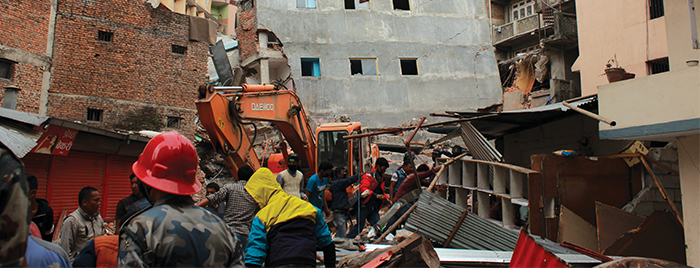Researchers who normally use high-resolution satellite imagery to study glaciers used their technology to help with disaster relief and longer-term stabilization planning efforts in Nepal.
In April 2015, a violent earthquake struck central Nepal, killing more than 7,000 people and destroying hundreds of thousands of homes. The deadliest earthquake in Nepal since 1934, the tremor killed at least 19 climbers and crew on Mount Everest and reportedly produced casualties in the adjoining countries of Bangladesh, China and India.
Two research teams – one at The Ohio State University and another at the University of Minnesota – are working quickly to produce high-resolution, 3-D digital surface maps for use in the Nepali relief effort. The Ohio Supercomputer Center is providing the computing power for data-intensive calculations that employ Surface Extraction for TIN-based Searchspace Minimization (SETSM) software.
“These data are critical for a range of uses, including mapping infrastructure, planning rescues and assessing slope stability,” explained Ian Howat, Ph.D., an associate professor of Earth Sciences at Ohio State and a principal investigator in the Glacier Dynamics Research Group at the university’s Byrd Polar and Climate Research Center. “Thus far, we have produced a mosaic that models the Kathmandu area with measurements at eight-meter intervals.”
“To support this effort, we have granted the SETSM team priority queuing and an emergency allocation of up to 60,000 core hours for use of our flagship supercomputer system, the Oakley Cluster,” said Brian Guilfoos, HPC Client Services Manager at the Ohio Supercomputer Center.
The SETSM software is a fully automatic algorithm for deriving the surface maps, called Digital Terrain Models, or DTMs. The maps are created from applying the algorithm to sets of overlapping pairs of high-resolution satellite images acquired by colleagues at the Polar Geospatial Center at the University of Minnesota. The satellite images are acquired from the Worldview-1 and Worldview-2 satellites, owned by DigitalGlobe Inc., and are licensed through the National Geospatial-Intelligence Agency’s NextView program. The Polar Geospatial Center will distribute the final products on the organization’s website.
“Besides improving on this DTM, we will be processing the entirely useable archive of Worldview stereo imagery over Nepal, starting this week, in order to expand coverage,” said Myoung-Jong Noh, a member of the Glacier Dynamics Research Group at the Byrd Center and the lead author of a scientific paper on SETSM in the journal GIScience & Remote Sensing.
Project Lead: Ian Howat, Ph.D., The Ohio State University
Research Title: Nepal Earthquake Elevation Model
Funding Source: National Aeronautics and Space Administration
Website: https://u.osu.edu/setsm/author/howat-4/

